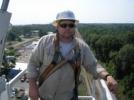We have a few windmills installed w protection toour system , but the dumb asses hooked it to our delta system, so whenever a ground the windmill is off , customer mad but our system still works w one but not too, no one has big enough solar to make a impact yet,
Results 1 to 9 of 9
Thread: Solar backfeed.
-
06-19-2012, 07:31 PM #1
 Solar backfeed.
Featured Sponsor
Solar backfeed.
Featured SponsorI don't know about America, but here in the UK the governments department of eco-themed free handouts is giving money hand over fist to solar panel companies to install their panels all over houses in situations where they will never pay their way due to our less than favourable levels of sunshine. What's perhaps more important though is that the systems are being installed by crash-course installers who are hooking them onto the incoming mains to the houses so they can put power back into the grid.
The inverters and controllers are supposed to prevent feeding of power onto the grid when it's down, but with the volume of equipment going in there's bound to be an issue where that defence system fails. I'm sure this won't be helped by the dumb monkey installation companies and whatever they do to "service" the equipment.
At least you can hear a generator in someones garage. Solar power backfeed is going to be silent.Portable defibrillators were first invented to save the lives of linemen. Where's yours?
www.bigclive.com
-
06-19-2012, 11:36 PM #2
 Senior Member
Senior Member
- Join Date
- May 2012
- Location
- Elyria,oh
- Posts
- 60

-
06-20-2012, 02:39 AM #3
 Administrator
Administrator
- Join Date
- Jan 2005
- Posts
- 322

We all need to test out how well any private generation can stand the test of being put straight to ground..... every time..
Or see how well the customer can pick up the line for us.
Either way, burn them up.
-
06-20-2012, 07:12 AM #4

It's been a while since I had an engineer deliver this topic to our Troubleshooters in an annual review but here is what I recall.
There are two meters on the house and one measures the usage from our power grid to the customer. The second measures the difference the customers photovoltaic system adds back to the power grid. The customers system canot close into our system unless there is voltage on our side. In other words if we took and outage, or the power grid went down due to a storm etc. the customers system has not got the potential to close on to our system. I used to have the schematic of this and I would guess the way we set it up is not everybodys choice. I think it was pretty safe if you were working inside a clearance and had your grounds on for protection. No customers installing a green energy system can not connect to our system till the relays are tested to operate correctly.
I know when a generator is backfeeding the power grid a ground will keep the power grid safe but as soon as you lift the ground the primary will be back via back feed instantly. A ground will not trip out a generator if the gound is applied to the primary and the generator is feeding the secondary.
-
06-20-2012, 01:38 PM #5
 Member
Member
- Join Date
- Mar 2012
- Location
- Northern California
- Posts
- 14

In America, solar is for the most part pretty benign. Since there is no rotating parts, during a fault it only feeds its normal load capability. Most residential units also can't run while there is no supply voltage. They need the 60Hz signal from the utility to sync up with. Wind mills are different though and are more like the typical generators.
Where I am at, there is only one meter and we recently did away with a separate disconnect for the solar. We pull the meter if we need to do any work.
-
06-20-2012, 08:05 PM #6

We have some of each type of ( FIT) feed in tarrif and ( REC) residential electric consumer and as T-man and others have said without AC power they are not supposed to be able to feed back onto the system, we require an outside disconnect and usually trip it off and pull the meter when working the line they feed from for dead, we also tag the transformer pole or padmount tx with a PV sticker. They claim they are safe and foolproof, but they are man made and in my opinion it's more important than ever to Open, Check Open, Test, Tag and Ground.
-
06-21-2012, 06:33 AM #7

I don't have the schematic right now but if the system is properly installed there is 2 meters, and a disconnect switch to isolate from our end. The big thing is if it has been installed properly. When working on a section of line that has been isolated, any transformers involved either need the secondary leads removed, or grounded. Always.
-
06-23-2012, 05:00 AM #8
 Senior Member
Senior Member
- Join Date
- Jan 2012
- Location
- Essex, UK
- Posts
- 122
 Quick reply from the beach
Quick reply from the beach
Clive,
I'm on my hols in Cyprus but thought I'd check in on the forum.
Lots of the sites we look after are buying into solar. Along with the G59 protection built into the kit we insist on a lockable main switch (mem exel type) between the kit and our distribution.
I understand from my local dno mates that they have to remove lv fuses on the transformer before working hv in case of any nasty private gdneratkon.
Stu
-
06-25-2012, 12:07 PM #9
 Senior Member
Senior Member
- Join Date
- Jul 2003
- Location
- Virginia, USA
- Posts
- 549
 Residential Solar
Featured Sponsorr
Residential Solar
Featured SponsorrI can't speak for the whole country but in Virginia a resisdential solar (less than 25 KW) has to have an inverter that meets Underwriters Laboratory UL standard #1741. That standard spells out that the DC to AC conversion must be sync with the independent Utility source. Another words you can generate all the DC you want but the only way to hook to the AC system is with a tested inverter. The second requirement is for an externally mounted lockable disconnect.
As some one else already said it just makes isolate TEST and Ground more important.



 Reply With Quote
Reply With Quote


